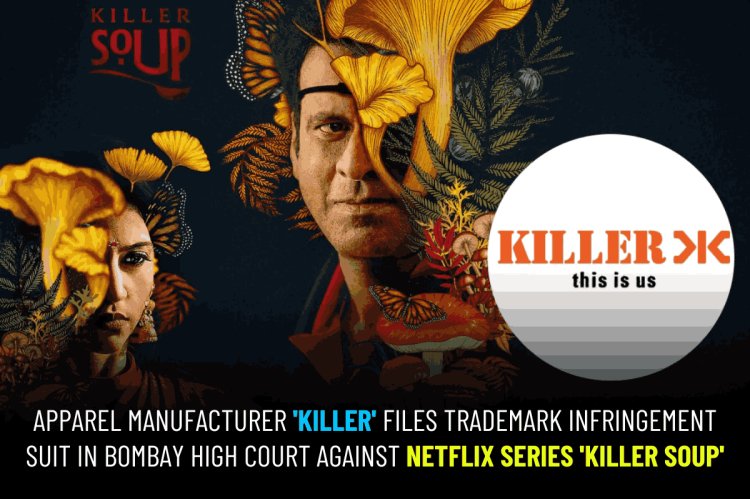Apparel Manufacturer 'Killer' Files Trademark Infringement Suit in Bombay High Court Against Netflix Series 'Killer Soup'
In the dynamic intersection of fashion and entertainment, trademark disputes often highlight the complexities of intellectual property law. The ongoing legal conflict between Killer Jeans, an established Indian fashion brand, and Netflix over the alleged infringement of "Killer Soup" offers valuable insights into the principles of trademark protection and the challenges of safeguarding brand identity. This blog provides a thorough analysis of this case, exploring key legal concepts, the implications for movie titles, and broader industry impacts.

Introduction
In today’s competitive market, protecting a brand's trademark is crucial for maintaining its identity and market position. The legal dispute between Killer Jeans and Netflix over the use of the term "Killer Soup" highlights significant issues in trademark law. This blog explores the case, examining the legal principles involved, the distinctiveness required for trademark protection, and the broader implications for brands in the entertainment industry.
Legal Framework for Trademark Protection
1. Indian Trademark Law
· Trademark Act, 1999: Governs the registration, protection, and enforcement of trademarks in India. It aims to protect marks that are distinctive and prevent infringement.
- Sections of Interest:
- Section 9: Relates to the refusal of registration for marks that are not distinctive or are descriptive.
- Section 11: Addresses the issue of similarity and potential confusion between marks.
2. Principles of Trademark Infringement
- Infringement Analysis: Involves determining if the mark is used without permission and whether it causes confusion among consumers about the origin of goods or services.
- Distinctiveness: Marks must be inherently distinctive or have acquired distinctiveness through use. Generic or descriptive terms face more stringent requirements for protection.
Case Analysis: Kewal Kiran Clothing Ltd v. Netflix Entertainment Services India LLP & Ors
Background
Killer Jeans is a prominent Indian fashion brand known for its denim and casual wear. The company has initiated legal action against Netflix, claiming that the streaming service’s use of "Killer Soup" as the title for a TV show infringes upon its registered trademark. Killer Jeans argues that this title is confusingly similar to its own brand name, potentially leading to consumer confusion and diluting its brand identity.
The crux of the dispute is whether "Killer Soup" infringes on the trademark of "Killer Jeans." The case presents an interesting intersection of fashion and entertainment, raising questions about how trademark laws apply across different industries.
Legal Principles
1. Trademark Infringement
- Definition: Trademark infringement occurs when a mark that is identical or confusingly similar to a registered trademark is used without authorization, leading to consumer confusion about the source or affiliation of the products or services.
- Assessment: The court will assess if "Killer Soup" creates a likelihood of confusion with "Killer Jeans." This involves evaluating visual, phonetic, and conceptual similarities between the two marks, as well as their respective goods or services.
2. Distinctiveness
- Definition: For a trademark to be protected, it must be distinctive enough to identify and differentiate the brand’s products or services from others. Trademarks are categorized based on their distinctiveness:
- Fanciful/Arbitrary Marks: Highly protected and inherently distinctive (e.g., "Killer Jeans").
- Suggestive Marks: Indicate a hint about the goods or services but require some imagination (e.g., "Killer Soup").
- Descriptive Marks: Describe the product or service and are less protected unless they acquire secondary meaning.
- Generic Marks: Not protected (e.g., generic terms for common products).
- Application: The distinctiveness of "Killer Jeans" is key. The term "Killer Soup" must be examined to determine if it is descriptive or if it has acquired distinctiveness that distinguishes it from "Killer Jeans."
3. Likelihood of Confusion
· Factors: Courts evaluate the likelihood of confusion by considering:
i. Similarity of Marks: Comparing how closely "Killer Soup" resembles "Killer Jeans" in appearance, sound, and meaning.
ii. Relatedness of Goods/Services: Assessing whether Netflix’s TV show and Killer Jeans’ fashion products are related or if there is any overlap in their consumer base.
iii. Marketing Channels: Determining if both brands use similar marketing strategies or platforms.
iv. Consumer Sophistication: Evaluating how discerning the average consumer is regarding the trademarks.
v. Evidence of Actual Confusion: Reviewing any instances where consumers have been confused about the association between the two marks.
4. Fair Use and Dilution
· Fair Use: This doctrine permits limited use of a trademark without permission under certain conditions:
i. Descriptive Fair Use: Using a term in its ordinary meaning to describe a product or service.
ii. Nominative Fair Use: Referring to a trademarked product or service for comparison or commentary.
· Dilution: Involves the weakening of a famous trademark’s distinctiveness or reputation. If Killer Jeans is a well-known brand, it may argue that "Killer Soup" dilutes its trademark, affecting its distinctiveness and reputation.
Court’s Judgement: The matter awaits adjudication before the Commercial Division of the Bombay High Court. Kewal Kiran contends a strong prima facie case with a balance of convenience in their favour, emphasizing the potential irreparable harm caused by Netflix and Macguffin’s alleged trademark infringement. The court is expected to evaluate the similarity between the ‘KILLER’ mark and ‘KILLER SOUP’ title, considering the likelihood of public confusion and potential damage to Kewal Kiran’s brand reputation.
Challenges with Protecting Movie Titles
Legal Challenges in Trademark Protection
1. Distinctiveness vs. Descriptiveness
- Distinctiveness: To qualify for trademark protection, a term or title must be distinctive. This means it should uniquely identify the source of goods or services. For example, "Killer Jeans" is distinctive because it uniquely identifies a fashion brand.
- Descriptive Titles: Titles that merely describe the product or service (e.g., "Killer Soup" if it describes the theme of a show) face difficulties in obtaining trademark protection. Descriptive marks are less protected unless they have acquired a secondary meaning through extensive use and recognition.
2. Likelihood of Confusion
- Similarity of Marks: The court will examine how similar "Killer Soup" is to "Killer Jeans" in terms of visual appearance, sound, and meaning. If the names are too similar, there may be a risk of consumer confusion.
- Relatedness of Goods/Services: The relatedness of the goods or services plays a role. Since "Killer Jeans" is in the fashion industry and "Killer Soup" is a TV show, the court will assess whether these disparate sectors could still lead to consumer confusion or dilution of the brand.
3. Market Overlap and Consumer Perception
- Market Overlap: Although fashion and entertainment are different sectors, the court will consider if there’s any potential overlap in consumer bases. If both target similar demographics or if the brand is well-known, the risk of confusion might be higher.
- Consumer Perception: How the average consumer perceives the similarity between "Killer Soup" and "Killer Jeans" is crucial. If consumers might mistakenly believe that there’s a connection between the two, this could support a claim of infringement.
Impact on Industry & Consumer perspective
The outcome of this case has broader implications for the fashion and entertainment industries. It highlights the importance of:
· Brand Protection: Ensuring that trademarks are not only distinctive but also protected against potential infringement.
· Entertainment Titles: Understanding how entertainment titles can impact established brands and the need for clear differentiation.
· Legal Precedents: Setting legal precedents for how similar disputes are handled in the future, influencing how brands across different sectors manage their intellectual property.
· Consumer Perspective: The potential for consumer confusion underscores the importance of clear branding and trademark protection. Consumers might be misled about the affiliation or endorsement between "Killer Soup" and "Killer Jeans," impacting brand loyalty and trust.
Conclusion
The trademark dispute between Killer Jeans and Netflix over "Killer Soup" highlights critical aspects of trademark law and its application to entertainment and fashion industries. By examining the principles of trademark infringement, distinctiveness, and fair use, we gain insights into how such cases are evaluated. The legal battle not only impacts the brands involved but also sets a precedent for future trademark disputes, emphasizing the importance of robust brand protection and clear differentiation in a crowded marketplace.












